Zihao Zhou
GeoSDF: Plane Geometry Diagram Synthesis via Signed Distance Field
Jun 16, 2025Abstract:Plane Geometry Diagram Synthesis has been a crucial task in computer graphics, with applications ranging from educational tools to AI-driven mathematical reasoning. Traditionally, we rely on computer tools (e.g., Matplotlib and GeoGebra) to manually generate precise diagrams, but it usually requires huge, complicated calculations cost. Recently, researchers start to work on learning-based methods (e.g., Stable Diffusion and GPT4) to automatically generate diagrams, saving operational cost but usually suffering from limited realism and insufficient accuracy. In this paper, we propose a novel framework GeoSDF to automatically generate diagrams efficiently and accurately with Signed Distance Field (SDF). Specifically, we first represent geometric elements in the SDF, then construct a series of constraint functions to represent geometric relationships, next we optimize such constraint functions to get an optimized field of both elements and constraints, finally by rendering the optimized field, we can obtain the synthesized diagram. In our GeoSDF, we define a symbolic language to easily represent geometric elements and those constraints, and our synthesized geometry diagrams can be self-verified in the SDF, ensuring both mathematical accuracy and visual plausibility. In experiments, our GeoSDF synthesized both normal high-school level and IMO-level geometry diagrams. Through both qualitative and quantitative analysis, we can see that synthesized diagrams are realistic and accurate, and our synthesizing process is simple and efficient. Furthermore, we obtain a very high accuracy of solving geometry problems (over 95\% while the current SOTA accuracy is around 75%) by leveraging our self-verification property. All of these demonstrate the advantage of GeoSDF, paving the way for more sophisticated, accurate, and flexible generation of geometric diagrams for a wide array of applications.
Review of Mathematical Optimization in Federated Learning
Dec 02, 2024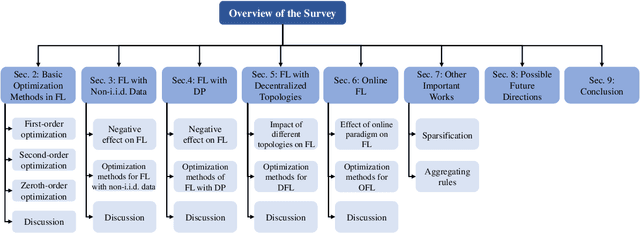
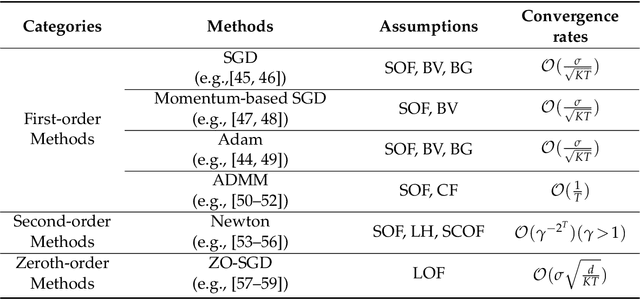
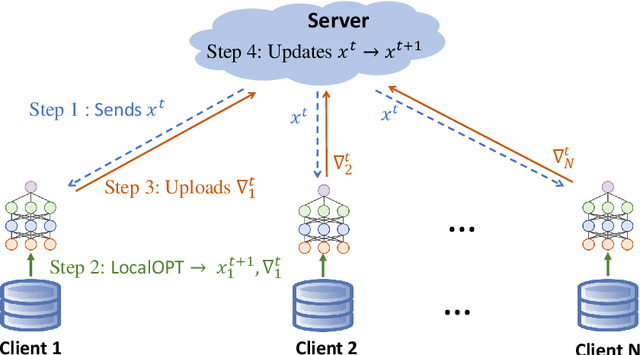

Abstract:Federated Learning (FL) has been becoming a popular interdisciplinary research area in both applied mathematics and information sciences. Mathematically, FL aims to collaboratively optimize aggregate objective functions over distributed datasets while satisfying a variety of privacy and system constraints.Different from conventional distributed optimization methods, FL needs to address several specific issues (e.g., non-i.i.d. data distributions and differential private noises), which pose a set of new challenges in the problem formulation, algorithm design, and convergence analysis. In this paper, we will systematically review existing FL optimization research including their assumptions, formulations, methods, and theoretical results. Potential future directions are also discussed.
Multi-Modal Forecaster: Jointly Predicting Time Series and Textual Data
Nov 21, 2024Abstract:Current forecasting approaches are largely unimodal and ignore the rich textual data that often accompany the time series due to lack of well-curated multimodal benchmark dataset. In this work, we develop TimeText Corpus (TTC), a carefully curated, time-aligned text and time dataset for multimodal forecasting. Our dataset is composed of sequences of numbers and text aligned to timestamps, and includes data from two different domains: climate science and healthcare. Our data is a significant contribution to the rare selection of available multimodal datasets. We also propose the Hybrid Multi-Modal Forecaster (Hybrid-MMF), a multimodal LLM that jointly forecasts both text and time series data using shared embeddings. However, contrary to our expectations, our Hybrid-MMF model does not outperform existing baselines in our experiments. This negative result highlights the challenges inherent in multimodal forecasting. Our code and data are available at https://github.com/Rose-STL-Lab/Multimodal_ Forecasting.
Federated Temporal Graph Clustering
Oct 16, 2024



Abstract:Temporal graph clustering is a complex task that involves discovering meaningful structures in dynamic graphs where relationships and entities change over time. Existing methods typically require centralized data collection, which poses significant privacy and communication challenges. In this work, we introduce a novel Federated Temporal Graph Clustering (FTGC) framework that enables decentralized training of graph neural networks (GNNs) across multiple clients, ensuring data privacy throughout the process. Our approach incorporates a temporal aggregation mechanism to effectively capture the evolution of graph structures over time and a federated optimization strategy to collaboratively learn high-quality clustering representations. By preserving data privacy and reducing communication overhead, our framework achieves competitive performance on temporal graph datasets, making it a promising solution for privacy-sensitive, real-world applications involving dynamic data.
Can LLMs Understand Time Series Anomalies?
Oct 07, 2024



Abstract:Large Language Models (LLMs) have gained popularity in time series forecasting, but their potential for anomaly detection remains largely unexplored. Our study investigates whether LLMs can understand and detect anomalies in time series data, focusing on zero-shot and few-shot scenarios. Inspired by conjectures about LLMs' behavior from time series forecasting research, we formulate key hypotheses about LLMs' capabilities in time series anomaly detection. We design and conduct principled experiments to test each of these hypotheses. Our investigation reveals several surprising findings about LLMs for time series: 1. LLMs understand time series better as *images* rather than as text 2. LLMs did not demonstrate enhanced performance when prompted to engage in *explicit reasoning* about time series analysis 3. Contrary to common beliefs, LLM's understanding of time series *do not* stem from their repetition biases or arithmetic abilities 4. LLMs' behaviors and performance in time series analysis *vary significantly* across different model architectures This study provides the first comprehensive analysis of contemporary LLM capabilities in time series anomaly detection. Our results suggest that while LLMs can understand time series anomalies, many common conjectures based on their reasoning capabilities do not hold. These insights pave the way for more effective LLM-based approaches in time series analysis, bridging the gap between forecasting and anomaly detection applications.
Back to Bayesics: Uncovering Human Mobility Distributions and Anomalies with an Integrated Statistical and Neural Framework
Oct 01, 2024Abstract:Existing methods for anomaly detection often fall short due to their inability to handle the complexity, heterogeneity, and high dimensionality inherent in real-world mobility data. In this paper, we propose DeepBayesic, a novel framework that integrates Bayesian principles with deep neural networks to model the underlying multivariate distributions from sparse and complex datasets. Unlike traditional models, DeepBayesic is designed to manage heterogeneous inputs, accommodating both continuous and categorical data to provide a more comprehensive understanding of mobility patterns. The framework features customized neural density estimators and hybrid architectures, allowing for flexibility in modeling diverse feature distributions and enabling the use of specialized neural networks tailored to different data types. Our approach also leverages agent embeddings for personalized anomaly detection, enhancing its ability to distinguish between normal and anomalous behaviors for individual agents. We evaluate our approach on several mobility datasets, demonstrating significant improvements over state-of-the-art anomaly detection methods. Our results indicate that incorporating personalization and advanced sequence modeling techniques can substantially enhance the ability to detect subtle and complex anomalies in spatiotemporal event sequences.
PSFHS Challenge Report: Pubic Symphysis and Fetal Head Segmentation from Intrapartum Ultrasound Images
Sep 17, 2024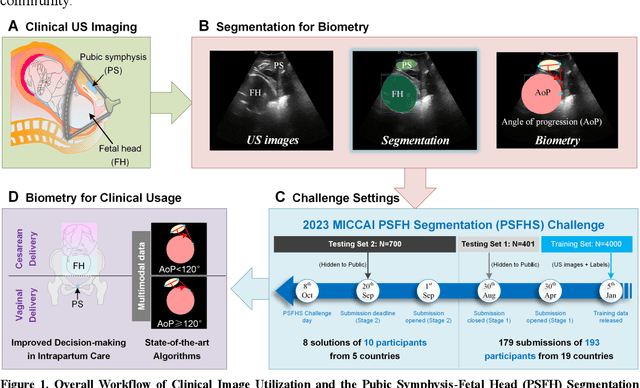

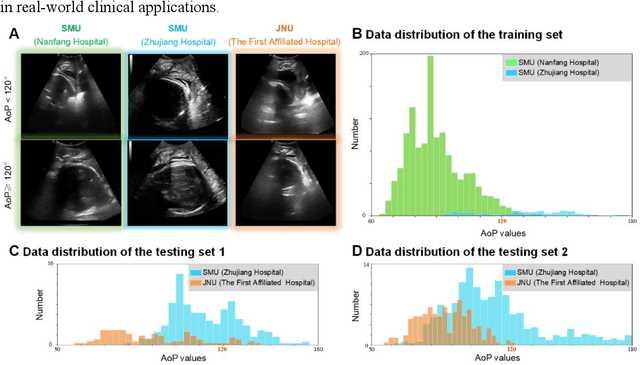

Abstract:Segmentation of the fetal and maternal structures, particularly intrapartum ultrasound imaging as advocated by the International Society of Ultrasound in Obstetrics and Gynecology (ISUOG) for monitoring labor progression, is a crucial first step for quantitative diagnosis and clinical decision-making. This requires specialized analysis by obstetrics professionals, in a task that i) is highly time- and cost-consuming and ii) often yields inconsistent results. The utility of automatic segmentation algorithms for biometry has been proven, though existing results remain suboptimal. To push forward advancements in this area, the Grand Challenge on Pubic Symphysis-Fetal Head Segmentation (PSFHS) was held alongside the 26th International Conference on Medical Image Computing and Computer Assisted Intervention (MICCAI 2023). This challenge aimed to enhance the development of automatic segmentation algorithms at an international scale, providing the largest dataset to date with 5,101 intrapartum ultrasound images collected from two ultrasound machines across three hospitals from two institutions. The scientific community's enthusiastic participation led to the selection of the top 8 out of 179 entries from 193 registrants in the initial phase to proceed to the competition's second stage. These algorithms have elevated the state-of-the-art in automatic PSFHS from intrapartum ultrasound images. A thorough analysis of the results pinpointed ongoing challenges in the field and outlined recommendations for future work. The top solutions and the complete dataset remain publicly available, fostering further advancements in automatic segmentation and biometry for intrapartum ultrasound imaging.
NUMOSIM: A Synthetic Mobility Dataset with Anomaly Detection Benchmarks
Sep 04, 2024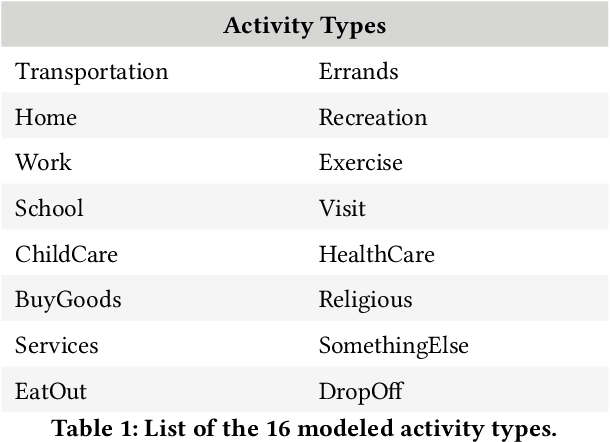
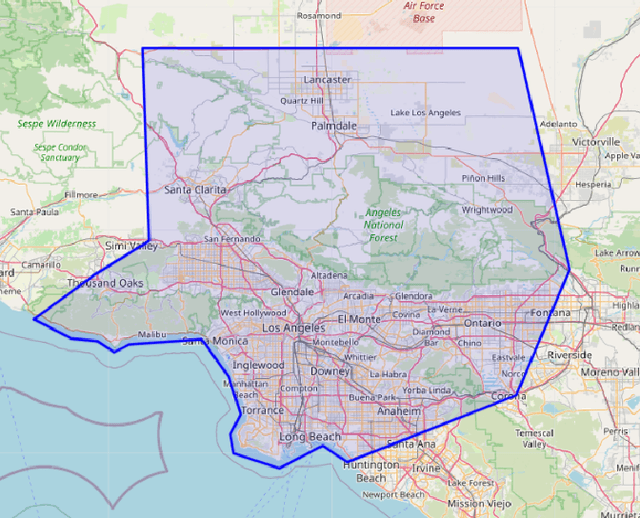
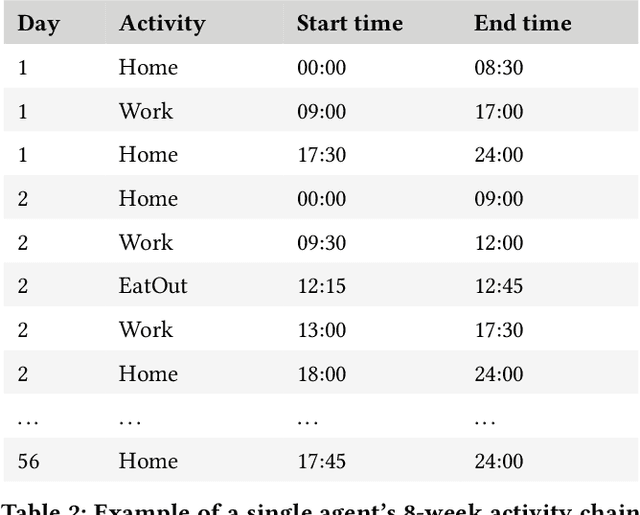
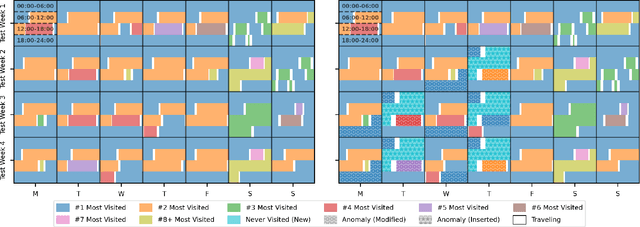
Abstract:Collecting real-world mobility data is challenging. It is often fraught with privacy concerns, logistical difficulties, and inherent biases. Moreover, accurately annotating anomalies in large-scale data is nearly impossible, as it demands meticulous effort to distinguish subtle and complex patterns. These challenges significantly impede progress in geospatial anomaly detection research by restricting access to reliable data and complicating the rigorous evaluation, comparison, and benchmarking of methodologies. To address these limitations, we introduce a synthetic mobility dataset, NUMOSIM, that provides a controlled, ethical, and diverse environment for benchmarking anomaly detection techniques. NUMOSIM simulates a wide array of realistic mobility scenarios, encompassing both typical and anomalous behaviours, generated through advanced deep learning models trained on real mobility data. This approach allows NUMOSIM to accurately replicate the complexities of real-world movement patterns while strategically injecting anomalies to challenge and evaluate detection algorithms based on how effectively they capture the interplay between demographic, geospatial, and temporal factors. Our goal is to advance geospatial mobility analysis by offering a realistic benchmark for improving anomaly detection and mobility modeling techniques. To support this, we provide open access to the NUMOSIM dataset, along with comprehensive documentation, evaluation metrics, and benchmark results.
Uncertainty is Fragile: Manipulating Uncertainty in Large Language Models
Jul 15, 2024



Abstract:Large Language Models (LLMs) are employed across various high-stakes domains, where the reliability of their outputs is crucial. One commonly used method to assess the reliability of LLMs' responses is uncertainty estimation, which gauges the likelihood of their answers being correct. While many studies focus on improving the accuracy of uncertainty estimations for LLMs, our research investigates the fragility of uncertainty estimation and explores potential attacks. We demonstrate that an attacker can embed a backdoor in LLMs, which, when activated by a specific trigger in the input, manipulates the model's uncertainty without affecting the final output. Specifically, the proposed backdoor attack method can alter an LLM's output probability distribution, causing the probability distribution to converge towards an attacker-predefined distribution while ensuring that the top-1 prediction remains unchanged. Our experimental results demonstrate that this attack effectively undermines the model's self-evaluation reliability in multiple-choice questions. For instance, we achieved a 100 attack success rate (ASR) across three different triggering strategies in four models. Further, we investigate whether this manipulation generalizes across different prompts and domains. This work highlights a significant threat to the reliability of LLMs and underscores the need for future defenses against such attacks. The code is available at https://github.com/qcznlp/uncertainty_attack.
Is Your Model Really A Good Math Reasoner? Evaluating Mathematical Reasoning with Checklist
Jul 11, 2024



Abstract:Exceptional mathematical reasoning ability is one of the key features that demonstrate the power of large language models (LLMs). How to comprehensively define and evaluate the mathematical abilities of LLMs, and even reflect the user experience in real-world scenarios, has emerged as a critical issue. Current benchmarks predominantly concentrate on problem-solving capabilities, which presents a substantial risk of model overfitting and fails to accurately represent genuine mathematical reasoning abilities. In this paper, we argue that if a model really understands a problem, it should be robustly and readily applied across a diverse array of tasks. Motivated by this, we introduce MATHCHECK, a well-designed checklist for testing task generalization and reasoning robustness, as well as an automatic tool to generate checklists efficiently. MATHCHECK includes multiple mathematical reasoning tasks and robustness test types to facilitate a comprehensive evaluation of both mathematical reasoning ability and behavior testing. Utilizing MATHCHECK, we develop MATHCHECK-GSM and MATHCHECK-GEO to assess mathematical textual reasoning and multi-modal reasoning capabilities, respectively, serving as upgraded versions of benchmarks including GSM8k, GeoQA, UniGeo, and Geometry3K. We adopt MATHCHECK-GSM and MATHCHECK-GEO to evaluate over 20 LLMs and 11 MLLMs, assessing their comprehensive mathematical reasoning abilities. Our results demonstrate that while frontier LLMs like GPT-4o continue to excel in various abilities on the checklist, many other model families exhibit a significant decline. Further experiments indicate that, compared to traditional math benchmarks, MATHCHECK better reflects true mathematical abilities and represents mathematical intelligence more linearly, thereby supporting our design. On our MATHCHECK, we can easily conduct detailed behavior analysis to deeply investigate models.
 Add to Chrome
Add to Chrome Add to Firefox
Add to Firefox Add to Edge
Add to Edge